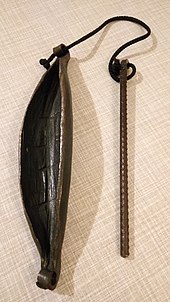Atoke
Atoke , also apitua, dawuro, banana bell, toke bell, slit bell, boat bell , is a boat-shaped surcharge idiophon made of forged iron of the Ewe in Ghana and beyond in West Africa .
distribution
The origin of the atoke is in Ghana, Togo and Benin . It can now also be found in Senegal and other West African countries and is part of the sound of many percussion ensembles. The atoke is an integral part of traditional Ewe and Ashanti music.
The similarity between the atoke and the Javanese kemanak was used by representatives of diffusionism , among them Arthur Morris Jones and Jaap Kunst , next to the xylophone as evidence for an early spread of Indonesian cultural elements to Africa until the middle of the 20th century .
Design
The atoke is available in sizes between 15 and 30 centimeters in length and up to 500 grams in weight. It is hand-forged from elongated iron sheet up to 5 millimeters thick . The smaller the atoke , the higher the tone produced. Like an African single or double bell, the idiophone produces a bright, penetrating, dry and short sound.
Style of play
The instrument lies in the hand and is struck with an iron pin on both of its upper edges. The sound of the atoke can be varied by opening and closing the palm. The atoke is occasionally used as a replacement for the double bell gankogui . It is suitable for accentuating play. Traditionally, the atoke is played in West African percussion ensembles with the drum dunun and serves as the meter for the ensemble.

Web links
- Sound sample Ashanti in Ghana (MP3 audio)
- Atoke demonstration (video)
Individual evidence
- ^ Arthur Morris Jones : Indonesia and Africa: The Xylophone as a Culture-Indicator. In: African Music, Vol. 2, No. 3, 1960, pp. 36–47, here p. 40
- ^ William Alves: Music of the Peoples of the World . Schirmer G Books Inc, 2012, ISBN 978-1-133-30794-5 .
- ^ Godfried T. Toussaint: The Geometry of Musical Rhythm: What Makes a "Good" Rhythm Good? CRC Press Inc, 2013.
